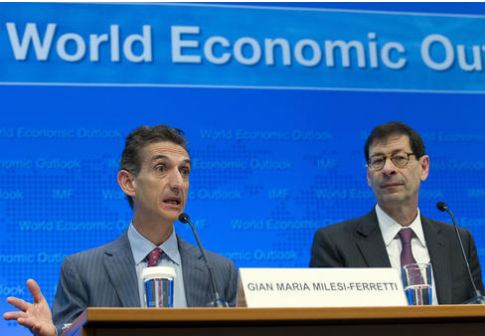The International Monetary Fund downgraded the economic growth outlook for the United States to 1.6 percent in 2016, which is the largest one-year drop seen for an advanced economy, according to the Fund’s World Economic Outlook report.
According to the report, the United States grew at a rate of 2.6 percent in 2015 and is projected to slow to 1.6 percent in 2016, a decline of 38 percent. The United States’ decline in growth is the largest one-year drop seen in all of the advanced economies such as the United Kingdom, Canada, Germany, Italy, and Spain.
"Softer-than-expected activity in the second half of 2015 and the first half of 2016 points to some loss in momentum in the United States, despite a mildly supportive fiscal stance and a slower projected pace of monetary policy normalization," the International Monetary Fund explains. "A prolonged inventory correction cycle and weak business investment has prompted a downward revision of the 2016 forecast to 1.6 percent."
The group projects that the economy will grow to 2.2 percent by 2017, but medium term growth will be held down at 1.8 percent due to an aging population and low productivity growth.
"The weakness in business fixed investment appears to reflect the continued (albeit moderating) decline in capital spending in the energy sector, the impact of recent dollar strength on investment in export-oriented industries, and possibly also the financial market volatility and recession fears of late 2015 and early 2016," the report says.
According to the International Monetary Fund, advanced economies are still feeling the effects of the global financial crisis. While progress has been made, the progress has been "uneven" and "crisis scars" are still visible in some countries.
For example, the group notes that the recovery in the United States is overstated by the decline in the unemployment rate.
"In some counties (such as the United States) the decline in unemployment to pre-crisis levels somewhat overstates the recovery in employment, given the decline in labor force participation," the report states. "This has not, however, been the case in other advanced economies, where in many cases participation rates are above pre-crisis levels."
Weaker-than-expected growth in the United States is one of the reasons why the International Monetary Fund cut its global growth projections. The group projected that global growth would slow to 3.1 percent in 2016 after growing 3.2 percent in 2015, citing the U.S. growth forecast as well as the Brexit vote.
"Economic growth in recent years has fallen short of expectations in both advanced and emerging market economies," the report says. "As the world economy moves further away from the global financial crisis, the factors affecting global economic performance are becoming more complex. They reflect a combination of global forces—demographic trends, a persistent decline in productivity growth, the adjustment to lower commodity prices—and shocks driven by domestic and regional factors."
Maurice Obstfeld, chief economist at the International Monetary Fund, says that U.S. growth has disappointed in 2016.
"The world economy has moved sideways," he said. "Without determined policy action to support economic activity over the short and longer terms, sub-par growth at recent levels risks perpetuating itself—through the negative economic and political forces it is unleashing."
